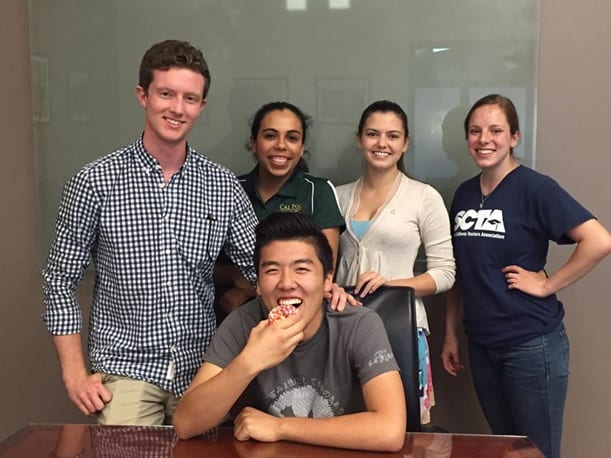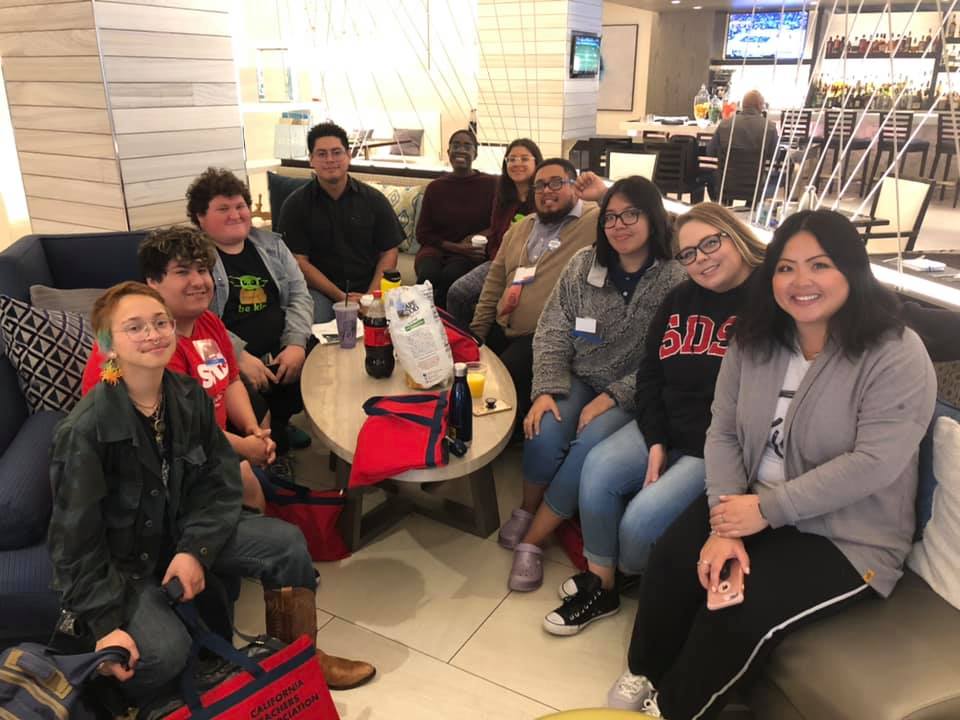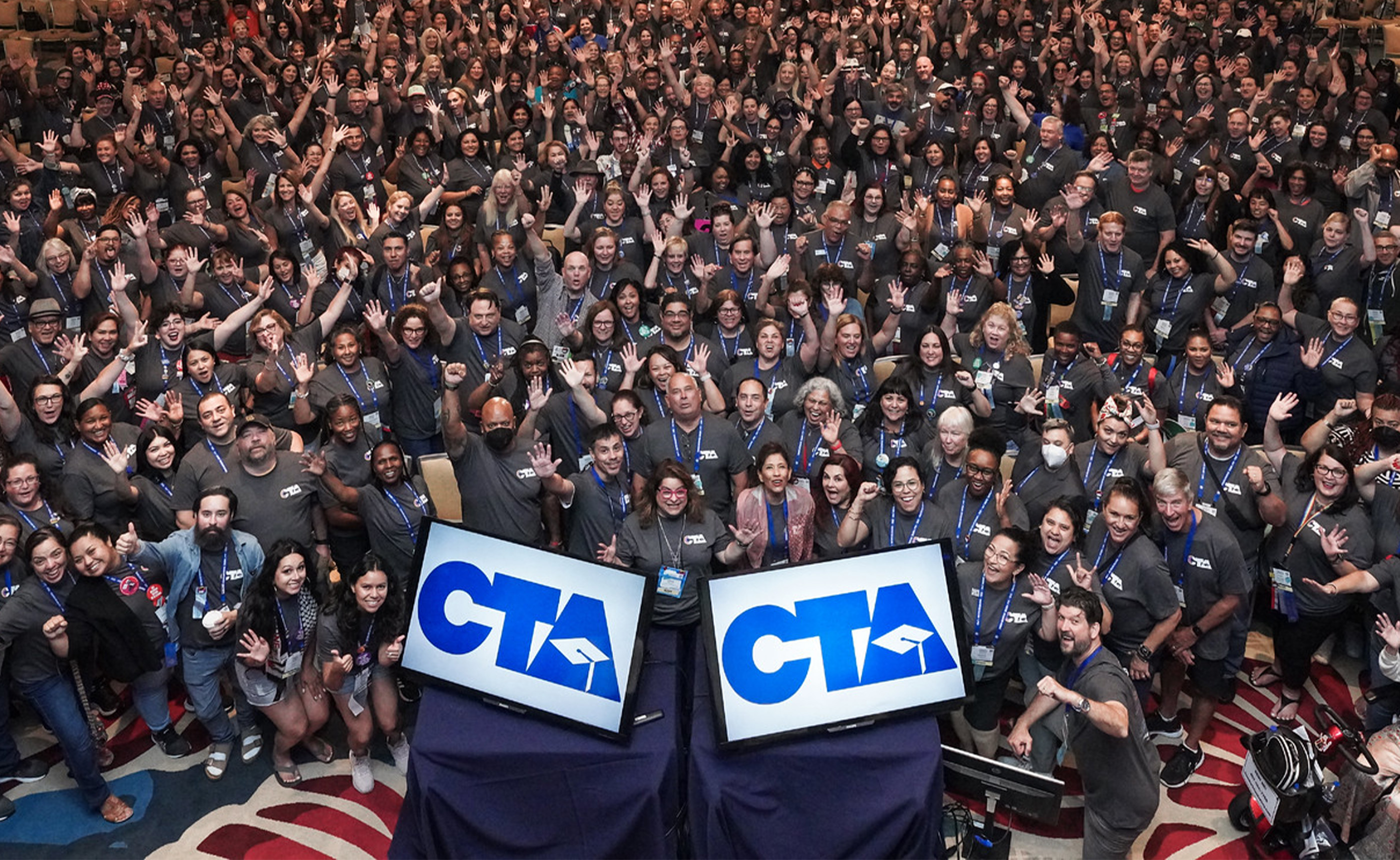Making Your CTA-AE Chapter Shine

Student chapters don’t have to operate in isolation. Get connected with the larger educational community in the state by developing partnership with local CTA chapters, CTA Service Center Councils, retired members, individual school sites, other CTA Aspiring Educators chapters, future teacher clubs at middle/ high schools and community organizations.
Get resources for funding, student awards, starting a chapter, planning events and more.
Start a New Chapter
In order to establish an official CTA-AE chapter on your campus, follow these procedures:
- Follow the procedures on your campus for establishing a club.
- Secure a faculty or staff advisor. We recommend 2 advisors, if possible, to share the responsibility. CTA-AE Chapter Advisors have the same responsibility as any other club advisor on campus.
- Send the following materials to the CTA-AE office:
- Chapter constitution (see a sample)
- List of officers and contact information
- Advisor contact information
Once this information is received, your chapter will be recognized. Next, open a chapter bank account and determine procedures for deposit and withdrawal of funds. Official chapters receive a rebate of $5.00 per member. Checks are mailed in the fall to the chapter advisor and are made payable to the chapter. Spring membership money will not be mailed until the next Fall.
Chapter Activities and Events
When planning chapter activities, consider developing events around four major areas:
Teacher Quality
Membership Recruitment
Community Outreach
Political Action
Fill Your Chapter’s Calendar
What to move your local chapter forward, but don’t know how to do it? Our Planning Calendar will help you know what to do and when.
Planning a Workshop or Mini Conference
Follow these eight steps for a well-organized and promoted workshop or mini-conference.
- First, plan what kind of event you want, and how big.
- Prepare a budget
- Secure student volunteers
- Select workshops to be offered.
- Request workshops two months in advance.
- Advertise event one month in advance.
- Day of the event
- After the event
Effective Meeting Tips
Running a meeting can be exhausting when people get sidetracked and the issue at hand gets forgotten. Follow these steps to help you run an effective meeting.
- Always start on time. Call the meeting to order at the scheduled start time and get right to the agenda.
- Adjourn on time. If there is a scheduled adjournment time, stick to it. No one likes a meeting that drags on forever.
- Keep oral reports brief. Ask officers and committee chairs to prepare written reports that they can duplicate and distribute as members arrive. Limit oral reports to any recommendations for action, the major reason(s) for the action, and questions and answers.
- Stick to the agenda. The chair should remind speakers to limit their remarks to the subject under consideration.
- Make use of unanimous consent. Instead of calling for a vote on a routine or noncontroversial motion, save time by declaring that unless there is an objection, the chair will consider the action taken.
- Keep the business portion of the meetings brief. For regular meetings of the chapter membership, keep the business meeting to about 10-15 minutes followed by a guest speaker or presentation. Planning committee meetings and meetings of the executive officers will usually be longer.
- Publicize meetings in advance. Advertise meetings by posting flyers, announcing in classes, email notices, posting on chapter website, including in student newspaper and personal invitation.
Sample Agenda
- Call to order
- Roll call (list those present)
III. Approval of minutes
- Adoption of agenda
- Officer reports
- Committee reports
VII. Old business
VIII. New business
- Announcements
- Adjournment
Note: An agenda listing committee reports, pending and special-ordered business should be compiled before the meeting and publicized widely, if possible.
Funding Sources
Be sure to open a bank account on behalf of your chapter in order to receive funds. Also, establish procedures for the deposit and withdrawal of chapter funds. The club office on your campus can help with this. Funding sources include NEA Grants, Chapter rebate checks, Associated Students and various local fundraising activities.
NEA Grants
There are a variety of sources for grants to support your chapter’s activities and events. The National Education Association’s Student Program (NEA-SP) has two grants that are available to student chapters across the country. For more information, contact the CTA-AE Office or check the NEA-SP website.
- CLASS Grant – Community Learning Through Americas Schools. Provides grants of up to $1000 to any student local chapter that is involved in a project to better the community.
- SOAR Grant – Student Organizing Assistance Resources. Provides grant money to assist state affiliates and local chapters in the recruitment of student members.
Also, check with community organizations and business that provide grants in your area.
Develop a relationship with your regional CTA Service Center Council Chair and staff. CTA divides the state into 26 regional Service Centers that provide support to local CTA and CTA-AE chapters. (For contact information for your local Service Center, contact the CTA-AE office).
Contact the Service Center and get on the mailing list for their meetings, trainings and events. Service Centers can sponsor students to attend CTA/CTA-AE statewide and regional conferences (i. e. Equity & Human Rights Conference, Good Teaching Conference, Fall Leadership Conference, etc.). They may also provide financial assistance for your chapter’s events (i. e. refreshments, speakers, copying, etc.)
Larger local CTA chapters may also be able to provide assistance to local student chapters.
Chapter Rebate Checks
Those campuses with official CTA-AE chapters receive rebates of $5.00 per student member. These checks are mailed in the fall to the chapter’s advisor, but made payable to the chapter. These funds may be used for chapter events.
Associated Students (AS)
Some campuses provide funds for club activities through Associated Students. Be sure to look into any available funds early in the year/ semester.
Fundraising Ideas
Here are some suggestions for fundraising activities for your local chapter:
- Concession booths at campus events
- Raffle prizes at campus club day events
- Car wash
- Student auction
- Barbeque
- Sell merchandise (t-shirts, decals, coffee mugs, etc.)
CTA-AE Awards
Each year CTA-AE recognizes the contributions of our members, chapters and advisors. CTA-AE Awards are presented at the CTA-AE Representative Assembly (the annual business meeting of the association) each spring.
Individual Award Categories
CTA-AE W.H.O. (We Honor Ours) Award is presented to an outstanding local chapter leader.
Outstanding Chapter Advisor(s) is presented to outstanding faculty or staff that excel in their role as local chapter advisor.
Virginia Ann Shadwick Human Rights Award is presented to a local CTA-AE chapter or CTA-AE member that has made a significant accomplishment in furthering human rights issues.
Chapter Award Categories
Outstanding Local Chapter is the most prestigious award given by CTA-AE . This award is presented to the chapter that has excelled in various categories.
Chapter Membership Recognition provides recognition to chapters for the greatest membership increase from the previous year (both numbers and percent) as well as the largest overall membership for the year.

